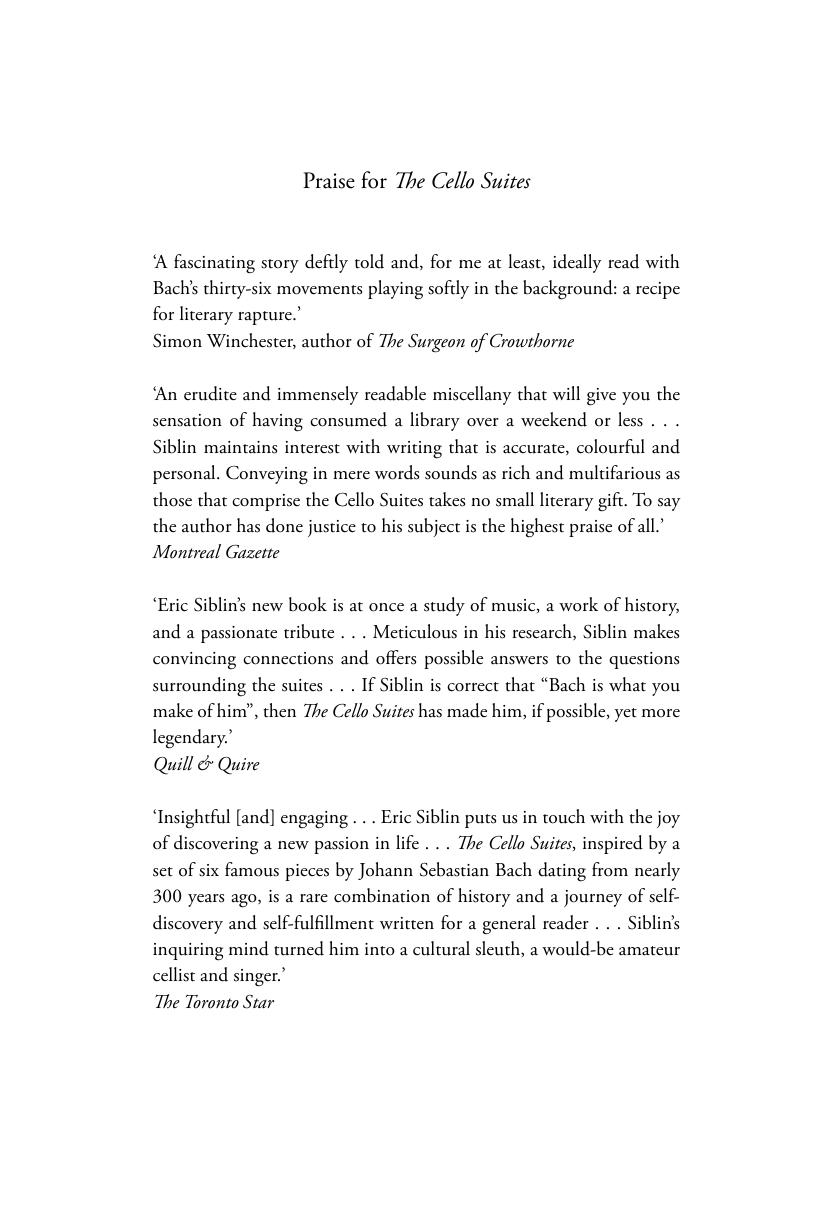The Cello Suites by Eric Siblin

Author:Eric Siblin
Language: eng
Format: epub, pdf
Tags: MUS020000
Publisher: House of Anansi Press Inc.
Published: 2009-03-21T16:00:00+00:00
SUITE NO. 5
C minor
PRELUDE
One feels a colossus in chains, a giant endeavouring to adjust his powers to the limitations of his medium of expression.
LEOPOLD GODOWSKY
THE NOTE OF foreboding is a C, the lowest string on the cello, played here as a curtain-raiser that is massive, ominous, and darkly majestic. The key is minor, and in the first brooding phrases a weary frame rests in the deepest registers — an old man telling an old story.
Here is how it came to this. Once upon a time these very notes were among the most illustrious in Europe. They knew splendour and extravagance; they were employed at the highest rungs of noble power. But they were surrounded by discord and difficulties.
A jaunty narrative takes shape. One voice after another comes in and out. The plot thickens. But is this the full story we are hearing, or one strand within a greater polyphony? Something feels incomplete.
This is the only suite of the six that calls for altered tuning of the strings (the technical term is scordatura), which means that the highest string on the cello, the A, is here tuned down one tone to a G. Why did Bach change the tuning? The experts are unsure. Quite possibly it’s designed to darken the mood.
Mystery surrounds the fifth suite. It is the only suite for which there exists another version composed by Bach, for another instrument — the lute. And the manuscript of this lute suite, in Bach’s own hand, has survived. It was dedicated to a mysterious “Monsieur Schouster.”
Several questions are raised by the time the cello, off on its clandestine fugal mission, trudges to the end in heavy boots. Why does the fifth cello suite, alone among the set, have a parallel existence as a lute suite? Which version was composed first, the fifth cello suite or the lute suite? And who was Mon sieur Schouster?
I FEEL A dizzying sensation when the librarian at the Royal Library of Belgium brings out the Bach autograph manuscript of the lute suite and places it without fuss on an oak desk. Bach’s calligraphy jumps out at me in a vertiginous rush of notes, staves, swirls, dots, smudges, stems, and beams with a beautiful, bold, curvaceous purpose.
I’m amazed that I can turn the pages without mandatory plastic gloves or anyone checking over my shoulder. I am touching something Bach touched. The tan paper is thick and sturdy. The title is in courtly French: Suite pour la Luth par J. S. Bach. The script is elegantly shaped, the S’s resembling the sound hole of a string instrument. The first of the movements is written out on two staves, piano-style, using bass and treble clefs for the high and low strings of the lute.
I turn the pages. There are five of them, written on both sides of the paper by what has been called the most beautiful, flowing hand in the history of music. The paper is browner at the edges, but in remarkably good shape, not creased, not dog-eared, perhaps not even well thumbed.
Download
This site does not store any files on its server. We only index and link to content provided by other sites. Please contact the content providers to delete copyright contents if any and email us, we'll remove relevant links or contents immediately.
The Goal (Off-Campus #4) by Elle Kennedy(12429)
Kathy Andrews Collection by Kathy Andrews(10517)
Diary of a Player by Brad Paisley(6866)
What Does This Button Do? by Bruce Dickinson(5525)
Assassin’s Fate by Robin Hobb(5236)
Big Little Lies by Liane Moriarty(4879)
Pale Blue Dot by Carl Sagan(4001)
Sticky Fingers by Joe Hagan(3454)
The Heroin Diaries by Nikki Sixx(2930)
The Death of the Heart by Elizabeth Bowen(2901)
Beneath These Shadows by Meghan March(2718)
The Help by Kathryn Stockett(2702)
Confessions of a Video Vixen by Karrine Steffans(2672)
How Music Works by David Byrne(2524)
Jam by Jam (epub)(2486)
Harry Potter 4 - Harry Potter and The Goblet of Fire by J.K.Rowling(2416)
Strange Fascination: David Bowie: The Definitive Story by David Buckley(2367)
Petty: The Biography by Warren Zanes(2236)
Darker Than the Deepest Sea by Trevor Dann(2206)
